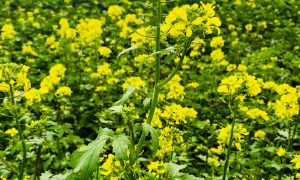Description
Unlike most other onions, it does not form bulbs and can be harvested at any stage of growth, from small seedlings to mature plants. It is a versatile ingredient that can be used in a variety of dishes, from salads to stir-fries, and is often used as a garnish or flavoring in Japanese cuisine. The Ishikura Long Winter onion is also known for its ability to withstand cold temperatures and can be grown in cooler climates.
What’s the Difference Between Ishikura Improved and Ishikura Long Winter Bunching Onions?
Ishikura Long Winter and Ishikura Improved are two different cultivars of Japanese bunching onions that share similar traits, but also have some distinct differences. Here are some of the key differences between the two:
- Appearance: Ishikura Long Winter onions have long, slender white stalks that are slightly thicker than green onions. Ishikura Improved onions have thicker stems and are more robust in appearance.
- Flavor: Ishikura Long Winter onions have a mild, sweet flavor that is often described as “earthy” or “nutty”. Ishikura Improved onions have a slightly stronger flavor that is more pungent.
- Harvest time: Ishikura Long Winter onions are typically grown during the winter season and take longer to mature than Ishikura Improved onions, which can be harvested throughout the year.
- Uses: Ishikura Long Winter onions are often used in Japanese cuisine as a garnish or flavoring, while Ishikura Improved onions are more versatile and can be used in a wide range of dishes.
How to Grow Bunching Onion “Ishikura Long Winter”
- Soil: Choose a well-draining soil that is rich in organic matter. The pH should be between 6.0 and 7.5.
- Planting: Ishikura Long Winter onions can be grown from seed or transplants. Plant the seeds or transplants 1 inch deep and 4-6 inches apart, in rows that are 12-18 inches apart. Plant them in late summer or early fall, about 8-10 weeks before the first expected frost.
- Watering: Keep the soil evenly moist, but not waterlogged. Water the onions deeply once a week, or more frequently during dry spells.
- Fertilizing: Side dress the onions with a balanced fertilizer after they have been growing for about 3-4 weeks. Repeat the fertilization every 3-4 weeks.
- Thinning: Once the onions have grown to about 6 inches tall, thin them so that they are about 2-3 inches apart. Use the thinned onions in cooking or salads.
- Harvesting: Harvest the onions when they are about 12-18 inches tall, usually after about 90 days. You can harvest them earlier if you prefer smaller onions. Cut the stalks at ground level and store them in a cool, dry place.
- Overwintering: Ishikura Long Winter onions are hardy and can survive the winter if you live in a mild climate. In colder regions, cover the onions with a thick layer of mulch to protect them from frost. They will resume growth in the spring.
Remember to monitor your onions for pests and diseases, and take appropriate measures to control them. With proper care and attention, you should be able to grow healthy and flavorful Ishikura Long Winter onions.
FAQ for Bunching Onion “Ishikura Long Winter”:
What are Ishikura Long Winter onions?
Ishikura Long Winter onions are a type of Japanese bunching onion that is typically grown during the winter season. They have long, slender white stalks that are slightly thicker than green onions and a mild, sweet flavor that is often described as “earthy” or “nutty”.
How are Ishikura Long Winter onions different from green onions?
While both Ishikura Long Winter onions and green onions belong to the same species (Allium fistulosum), Ishikura Long Winter onions have thicker stems, longer stalks, and a milder, sweeter flavor. They are also typically grown during the winter season.
When should I plant Ishikura Long Winter onions?
Ishikura Long Winter onions should be planted in late summer or early fall, about 8-10 weeks before the first expected frost. This allows them to grow during the cooler months and be ready for harvest in the winter or early spring.
How should I plant Ishikura Long Winter onions?
Ishikura Long Winter onions can be grown from seed or transplants. Plant the seeds or transplants 1 inch deep and 4-6 inches apart, in rows that are 12-18 inches apart. The soil should be well-draining and rich in organic matter.
How often should I water Ishikura Long Winter onions?
Keep the soil evenly moist, but not waterlogged. Water the onions deeply once a week, or more frequently during dry spells. Overwatering can lead to rot and other diseases, so be careful not to overdo it.
How should I fertilize Ishikura Long Winter onions?
Side dress the onions with a balanced fertilizer after they have been growing for about 3-4 weeks. Repeat the fertilization every 3-4 weeks. Too much fertilizer can cause the onions to grow too quickly and become less flavorful.
When should I harvest Ishikura Long Winter onions?
Harvest the onions when they are about 12-18 inches tall, usually after about 90 days. You can harvest them earlier if you prefer smaller onions. Cut the stalks at ground level and store them in a cool, dry place.
How can I store Ishikura Long Winter onions?
Ishikura Long Winter onions can be stored in a cool, dry place for several weeks. You can also freeze them for later use. To freeze, chop the onions into small pieces and spread them on a baking sheet. Once frozen, transfer the pieces to a freezer-safe container.
What are some common pests and diseases that affect Ishikura Long Winter onions?
Common pests that affect Ishikura Long Winter onions include onion maggots, thrips, and cutworms. Diseases that can affect the onions include downy mildew, botrytis blight, and pink root. Monitor your onions regularly for signs of pests or diseases and take appropriate measures to control them.
How can I use Ishikura Long Winter onions in cooking?
Ishikura Long Winter onions are a versatile ingredient that can be used in a variety of dishes, from salads to stir-fries. They are often used as a garnish or flavoring in Japanese cuisine. You can also pickle them or use them in soups and stews.





Reviews
There are no reviews yet.